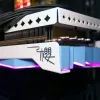Test Environment & Equipment
Here is where we begin the benchmark portion of this article, but first, let me show you our test system plus the software we used.
Note: The platform is different than the one used by Hilbert in his GPU review
Mainboard
ASUS Z790 Maximus HERO - Review
Processor
Intel Core i9 13900K @ defaults - Review
Graphics Cards
- Radeon RX 7800XT (Yeston Sakura Hitomi)
Memory
32 GB (2x 16GB) DDR5 7200 MHz
Power Supply Unit
1300 Watts Titanium Certified Seasonic Prime TX-1300 - Review
Monitor
WQHD Monitor at resolutions 1920x1080, 2560x1440
OS related software
Windows 11 64-bit
DirectX 9/10/11/12 End-User Runtime (Download)
AMD Radeon Software Driver Latest available (Download)
NVIDIA GeForce Driver Latest available (Download)
A Word About “FPS”
What are we looking for in gaming, performance-wise? First off, Guru3D tends to think that all games should be played at the best image quality (IQ) possible. There’s a dilemma, though: IQ often interferes with the performance of a graphics card. We measure this in FPS, the number of frames a graphics card can render per second; the higher it is, the more fluently your game will display itself.
A game’s frames per second (FPS) is a measured average of a series of tests. That test is often a time demo, a recorded part of the game which is a 1:1 representation of the actual game and its gameplay experience. After forcing the same image quality settings, the demo is used for all graphics cards this time so that the precise measuring is as objective as possible.
- 60 FPS Best possible gameplay
- So if a graphics card barely manages less than 30 FPS, the game is not very playable; we want to avoid that at all costs.
- With 30 FPS up to roughly 40 FPS, you can play the game with perhaps a tiny stutter at certain graphically intensive parts. Overall, it was an enjoyable experience. Match the best possible resolution to this result, and you’ll have the best possible rendering quality versus resolution; hey, you want both of them to be as high as possible.
- When a graphics card is doing 60 FPS on average or higher, you can rest assured that the game will likely play extremely smoothly at every point in the game and turn on every possible in-game IQ setting.
- Over 100 FPS? You either have a MONSTER graphics card or a very old game.
Monitor Setup
What Are You Looking For?
- Top bar - This simple test pattern is evenly spaced from 0 to 255 brightness levels, with no profile embedded. If your monitor is correctly set up, you should be able to distinguish each step, which should be visually distinct from its neighbors by the same amount. Also, the differences between the dark-end and light-end steps should be about the same. Finally, the first step should be completely black.
- The three lower blocks - The far left box is a black box within the middle, a little box a tint lighter than black. The middle box is a lined square with a central grey square. The far-right white box has a smaller “grey” box that should barely be visible.
You should be able to distinguish all minor differences; only then is your monitor set up properly contrast and saturation-wise.



